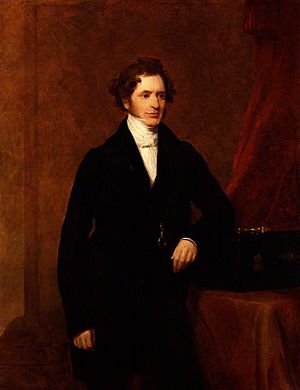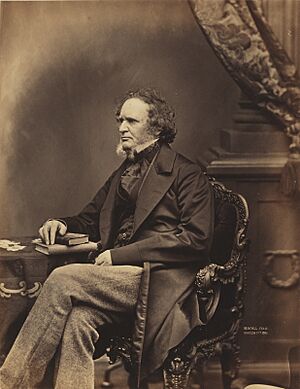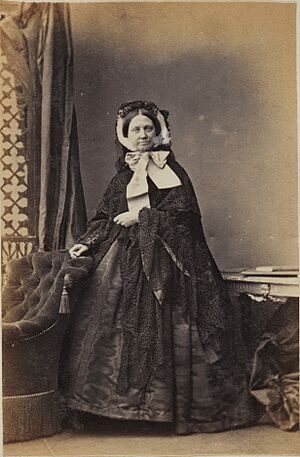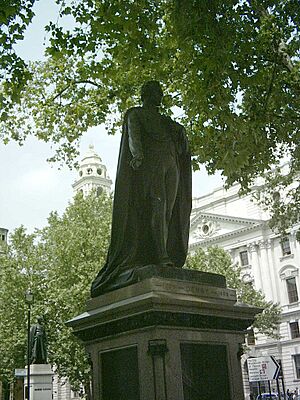Edward Smith-Stanley, 14th Earl of Derby facts for kids
Quick facts for kids
The Earl of Derby
|
|
|---|---|
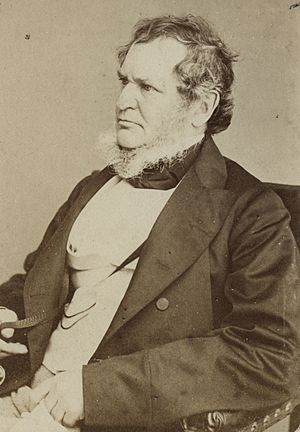
Lord Derby in 1865
|
|
| Prime Minister of the United Kingdom | |
| In office 28 June 1866 – 25 February 1868 |
|
| Monarch | Victoria |
| Preceded by | The Earl Russell |
| Succeeded by | Benjamin Disraeli |
| In office 20 February 1858 – 11 June 1859 |
|
| Monarch | Victoria |
| Preceded by | The Viscount Palmerston |
| Succeeded by | The Viscount Palmerston |
| In office 23 February 1852 – 17 December 1852 |
|
| Monarch | Victoria |
| Preceded by | The Earl Russell |
| Succeeded by | The Earl of Aberdeen |
| Secretary of State for War and the Colonies | |
| In office 3 September 1841 – 23 December 1845 |
|
| Prime Minister | Sir Robert Peel |
| Preceded by | The Earl Russell |
| Succeeded by | William Ewart Gladstone |
| In office 3 April 1833 – 5 June 1834 |
|
| Prime Minister | The Earl Grey |
| Preceded by | The Viscount Goderich |
| Succeeded by | Thomas Spring Rice |
| Chief Secretary for Ireland | |
| In office 29 November 1830 – 29 March 1833 |
|
| Prime Minister | The Earl Grey |
| Preceded by | Sir Henry Hardinge |
| Succeeded by | Sir John Hobhouse |
| Personal details | |
| Born | 29 March 1799 Knowsley Hall, Knowsley, Lancashire, England |
| Died | 23 October 1869 (aged 70) Knowsley Hall, Knowsley, Lancashire, England |
| Political party | Conservative |
| Other political affiliations |
Whig (before 1841) |
| Spouse | |
| Children | 3, including Edward and Frederick |
| Parents |
|
| Alma mater | Christ Church, Oxford |
| Signature |  |
Edward George Geoffrey Smith-Stanley, 14th Earl of Derby (born March 29, 1799 – died October 23, 1869), was a very important British politician. He was known as Edward Stanley before 1834, and then as Lord Stanley until 1851. He served as Prime Minister of the United Kingdom three times. He is also the longest-serving leader of the Conservative Party in history.
Lord Derby came from one of Britain's oldest and wealthiest families. He was one of only four British prime ministers to lead the country three or more separate times. His governments, however, each lasted less than two years. He helped create the state education system in Ireland and made important changes to Parliament.
For a long time, historians didn't pay much attention to his role. But in recent years, they have started to rank him highly among all British prime ministers.
Contents
Early Life and Education
Edward Stanley was born at Knowsley Hall in Lancashire, England. His father was the 13th Earl of Derby. His family, the Stanleys, were a very old and rich landowning family. Their main home was Knowsley Hall. Edward Stanley is thought to have been the richest Prime Minister in British history before 2022. His family owned huge amounts of land, about 57,000 acres, which brought in a lot of money.
He went to school at Eton College and then to Christ Church, Oxford university. Edward believed strongly in traditional ways and protecting people's property rights. He also had strong religious beliefs, which often guided his decisions.
Starting His Political Career (1822–1852)
In 1822, Edward Stanley became a Member of Parliament (MP) for Stockbridge. He was part of the Whig party, which was his family's traditional political group.
In 1830, when the Whigs came back into power, Stanley became the Chief Secretary for Ireland. He joined the Cabinet, which is a group of top government ministers, in 1831. As Chief Secretary, he introduced some strict rules in Ireland. He also wrote the Stanley Letter in October 1831. This letter created the system of National Education in Ireland, which is still the basis for primary schools there today.
In 1833, Stanley took on a more important role as Secretary of State for War and the Colonies. In this job, he helped pass the Abolition of Slavery Bill. This law ended slavery in most British colonies.
Stanley was a very religious Anglican. In 1834, he disagreed with the government's plans to change the Anglican Church of Ireland. He resigned from the government because of this. He then formed a group called the "Derby Dilly". This group tried to find a middle ground between the Whigs and the more traditional Tories.
Over the next few years, Stanley and his group slowly joined the Conservative Party, led by Robert Peel. In 1841, Stanley became Colonial Secretary again in Peel's government. In 1844, he moved to the House of Lords, which is the upper house of Parliament. He became known as Lord Stanley of Bickerstaffe.
In 1845, he disagreed with Prime Minister Peel again, this time over the repeal of the Corn Laws. These laws had kept the price of corn high. Stanley led most of the Conservative Party, including a young Benjamin Disraeli, in opposing this change. After this, he became the leader of the part of the Conservative Party that wanted to protect British trade. In 1851, he became the Earl of Derby after his father passed away.
Serving as Prime Minister (1852–1869)
Edward Stanley, the Earl of Derby, is the only modern Prime Minister who never had a clear majority of support in Parliament. This meant his governments often struggled to pass laws.
First Time as Prime Minister
Derby became Prime Minister for the first time in February 1852. His government was a minority government, meaning it didn't have a majority of MPs. In this government, Benjamin Disraeli became the Chancellor of the Exchequer, in charge of the country's money. Many experienced Conservative ministers had left the party, so Derby had to appoint many new people to his Cabinet.
When the very old and deaf Duke of Wellington heard the list of new, inexperienced ministers, he famously shouted "Who? Who?". Because of this, Derby's first government became known as the "Who? Who?" ministry.
Derby's governments were once thought to be mostly controlled by Disraeli. However, new research shows that Derby had a strong influence, especially in how Britain dealt with other countries. He wanted to avoid wars and work with other nations to solve problems peacefully.
In the election of June 1852, Derby's Conservative party won 330 seats. This was not enough for a clear majority. His government faced challenges from other groups in Parliament. When Disraeli presented his first budget in December 1852, it was not popular. It was voted down, and Derby's government fell.
After this, Lord Aberdeen formed a new government. When Aberdeen's government also fell in 1855, Queen Victoria asked Derby to form a government again. But Derby refused. He believed he could form a stronger government later, after other parties had tried and failed.
Second Time as Prime Minister
In 1858, Derby became Prime Minister for the second time. This happened after Lord Palmerston resigned. Disraeli was again in charge of the country's money and led the House of Commons.
One important thing this government did was to end the British East India Company. This company had ruled India for a long time. After the Indian Rebellion of 1857, India came under direct control of the British government for the first time.
This government also didn't last long, only about a year. It resigned after losing a vote of no-confidence. This vote was brought by different Whig and Radical groups who were coming together to form the Liberal Party. In July 1859, Derby was honored with the Order of the Garter, a very important award.
Back in opposition, Derby tried to get Prime Minister Palmerston to move away from his more radical friends. But this plan didn't work. Palmerston remained Prime Minister until he died in 1865.
Third Time as Prime Minister
Derby became Prime Minister for the third and final time in 1866. This happened after Lord Russell's government failed to pass new laws about voting. Once again, Disraeli was a key figure in Derby's government.
This government is famous for passing the Reform Act 1867. This law greatly expanded who could vote in Britain. However, it caused three of Derby's top ministers to resign, including Lord Cranborne (who later became Prime Minister himself). In early 1868, Derby retired from politics due to health reasons. Disraeli then took over as Prime Minister. In 1869, Derby received another important honor, the Order of St Michael and St George.
Even though he was a great speaker, some people criticized Derby for not always being a strong leader. Still, he achieved many important things as a minister and Prime Minister. He is often called the "father of the modern Conservative Party." He led the Conservative Party for 22 years, which is the longest time any party leader has served in British history.
Family Life
Edward Stanley married Emma Bootle-Wilbraham on May 31, 1825. They had three children:
- Edward Henry Stanley, 15th Earl of Derby (born July 21, 1826 – died April 21, 1893).
- Lady Emma Charlotte Stanley (born December 25, 1835 – died August 23, 1928). She married Wellington Patrick Manvers Chetwynd Talbot and they had eight children.
- Frederick Arthur Stanley, 16th Earl of Derby (born January 15, 1841 – died June 14, 1908). He married Lady Constance Villiers and they had ten children.
Derby's ancestors were important figures in the Isle of Man for centuries. One famous ancestor, Thomas Stanley, 1st Earl of Derby, switched sides during the Battle of Bosworth Field and helped Henry Tudor become king.
His Legacy and Namesakes
The National School system in Ireland, which is the main type of primary school, is still based on the system Edward Stanley set up in the Stanley Letter. This letter tried to solve the difficult problem of different Christian religions living together in Ireland.
Several places around the world are named after Edward Smith-Stanley:
- The area of Derby in Canada was named by the Royal Engineers in 1858, likely in his honor.
- Stanley (also called "Port Stanley"), the capital of the Falkland Islands, is named after him.
- Port Stanley in Canada is also named after him.
- The area of Stanley in Hong Kong is named after him.
- A boarding house at Wellington College in England is named "Stanley" after him.
- The county of Stanley in Queensland, Australia, which includes the city of Brisbane, is named after the Earl.
A funny story about his legacy: A library book about Smith-Stanley, called The Earl of Derby, was borrowed from a library in New Zealand in 1902. It was returned in 2020, 118 years later, after being found in Australia! The book was said to be "in OK condition."
See also
 In Spanish: Edward Smith-Stanley para niños
In Spanish: Edward Smith-Stanley para niños


